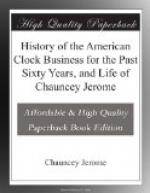Chauncey Boardman, of Bristol, Riley Whiting, of Winsted, and Asa Hopkins, of Northfield, were all engaged in the manufacture of the old fashioned hang-up clock. Butler Dunbar, an old schoolmate of mine, and father of Col. Edward Dunbar, of Bristol, was engaged with Dr. Titus Merriman in the same business. They all gave up the business after a few years.
Mr. Eli Terry (in the year 1814,) invented a beautiful shelf clock made of wood, which completely revolutionized the whole business. The making of the old fashioned hang-up wood clock, about which I have been speaking, passed out of existence. This patent article Mr. Terry introduced, was called the Pillar Scroll Top Case. The pillars were about twenty-one inches long, three-quarters of an inch at the base, and three-eights at the top—resting on a square base, and the top finished by a handsome cap. It had a large dial eleven inches square, and tablet below the dial seven by eleven inches. This style of clock was liked very much and was made in large quantities, and for several years. Mr. Terry sold a right to manufacture them to Seth Thomas, for one thousand dollars, which was thought to be a great sum. At first, Terry and Thomas made each about six thousand clocks per year, but afterwards increased to ten or twelve thousand. They were sold for fifteen dollars apiece when first manufactured. I think that these two men cleared about one hundred thousand dollars apiece, up to the year 1825. Mr. Thomas had made a good deal of money on the old fashioned style, for he made a good article, and had but little competition, and controlled most of the trade.
In 1818, Joseph Ives invented a metal clock, making the plates of iron and the wheels of brass. The movement was very large, and required a case about five feet long. This style was made for two or three years, but not in large quantities.
In the year 1825, the writer invented a new case, somewhat larger than the Scroll Top, which was called the Bronze Looking-Glass Clock. This was the richest looking and best clock that had ever been made, for the price. They could be got up for one dollar less than the Scroll Top, yet sold for two dollars more.
CHAPTER III.
PERSONAL HISTORY CONTINUED.—COMMENCING BUSINESS.—SALE TO A SOUTHERNER.—REMOVAL TO BRISTOL.—FIRST SERIOUS LOSS.




